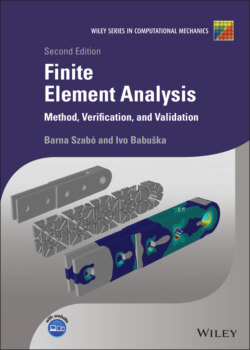Читать книгу Finite Element Analysis - Barna Szabó - Страница 21
1.2.2 The principle of minimum potential energy
ОглавлениеTheorem 1.2 The function that satisfies for all minimizes the quadratic functional8 , called the potential energy;
(1.36)
on the space .
Proof: For any , we have:
(1.37)
where unless . Therefore any admissible nonzero perturbation of u will increase .
This important theorem, called the theorem or principle of minimum potential energy, will be used in Chapter 7 as our starting point in the formulation of mathematical models for beams, plates and shells.
Given the potential energy and the space of admissible functions, it is possible to determine the strong form. This is illustrated by the following example.
Example 1.2 Let us determine the strong form corresponding to the potential energy defined by
(1.38)
with .
Since u minimizes , any perturbation of u by will increase . Therefore is minimum at and hence
(1.39)
Therefore we have
(1.40)
where the last two terms are zero because . Integrating the first term by parts,
and, substituting this into eq. (1.40), we get
(1.41)
Since this holds for all , the bracketed expression must be zero. In other words, the solution of the differential equation
(1.42)
minimizes the potential energy defined by eq. (1.38). This is the strong form of the problem.
Remark 1.2 The procedure in Example 1.2 is used in the calculus of variations for identifying the differential equation, known as the Euler9‐Lagrange10 equation, the solution of which maximizes or minimizes a functional. In this example the solution minimizes the potential energy on the space .
Remark 1.3 Whereas the strain energy is always positive, the potential energy may be positive, negative or zero.
